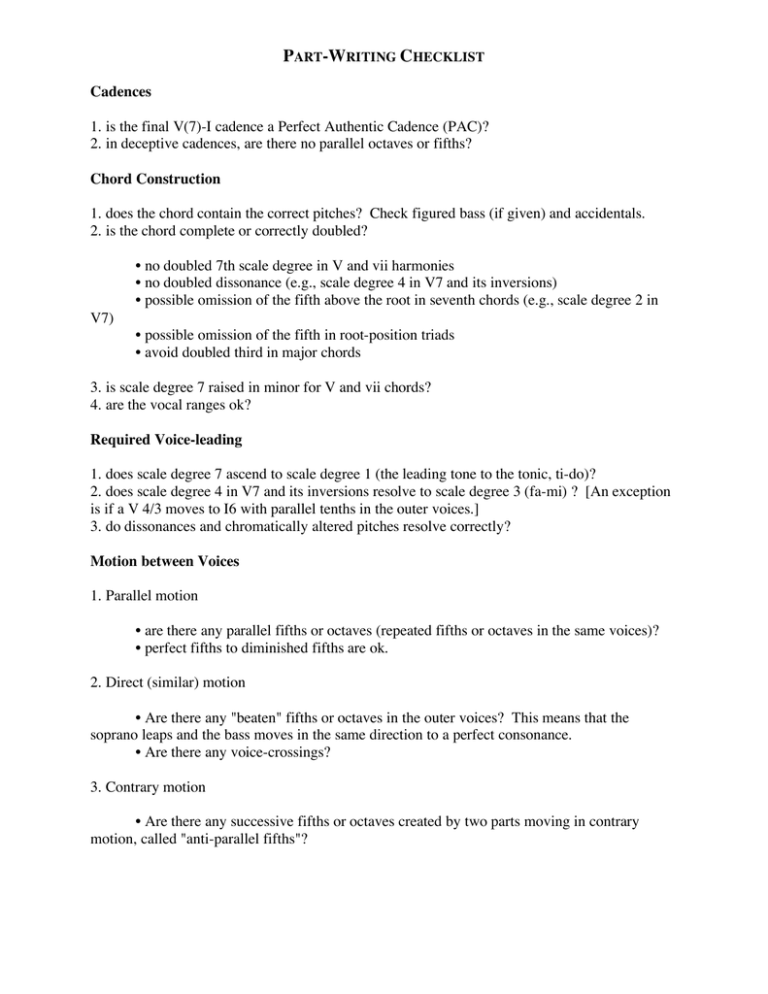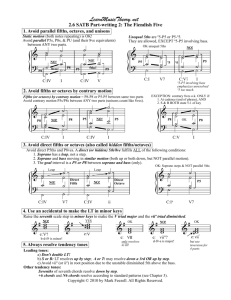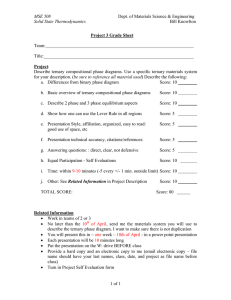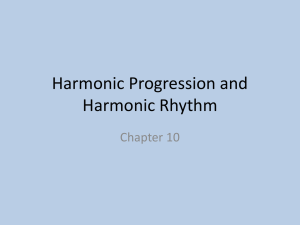P -W C
advertisement

PART-WRITING CHECKLIST Cadences 1. is the final V(7)-I cadence a Perfect Authentic Cadence (PAC)? 2. in deceptive cadences, are there no parallel octaves or fifths? Chord Construction 1. does the chord contain the correct pitches? Check figured bass (if given) and accidentals. 2. is the chord complete or correctly doubled? • no doubled 7th scale degree in V and vii harmonies • no doubled dissonance (e.g., scale degree 4 in V7 and its inversions) • possible omission of the fifth above the root in seventh chords (e.g., scale degree 2 in V7) • possible omission of the fifth in root-position triads • avoid doubled third in major chords 3. is scale degree 7 raised in minor for V and vii chords? 4. are the vocal ranges ok? Required Voice-leading 1. does scale degree 7 ascend to scale degree 1 (the leading tone to the tonic, ti-do)? 2. does scale degree 4 in V7 and its inversions resolve to scale degree 3 (fa-mi) ? [An exception is if a V 4/3 moves to I6 with parallel tenths in the outer voices.] 3. do dissonances and chromatically altered pitches resolve correctly? Motion between Voices 1. Parallel motion • are there any parallel fifths or octaves (repeated fifths or octaves in the same voices)? • perfect fifths to diminished fifths are ok. 2. Direct (similar) motion • Are there any "beaten" fifths or octaves in the outer voices? This means that the soprano leaps and the bass moves in the same direction to a perfect consonance. • Are there any voice-crossings? 3. Contrary motion • Are there any successive fifths or octaves created by two parts moving in contrary motion, called "anti-parallel fifths"? MU 201 Midterm Evaluations Fall 2006 NO NAMES PLEASE!!! I. What do you think is working well in the class? II. What do you think is NOT working well in the class? Multiple choice: Example 1: Mendelssohn "Song without Words" 1. what is overall form? a) simple ternary, b) simple ternary with intro and coda c) compound ternary with intro and coda 2. What type of sequence is in bars 16-18? a) descending 5ths b) ascending 5ths c) parallel 10ths 3. in measure 42, one expects to hear a I chord, but instead there is: a) º vii 4-3 of ii b) º vii 4-3 of vi c) I 6-4 Example 2: Chopin, Prelude in Db Major (the "Raindrop prelude") 1. The overall form of the first 8 measures is: a) parallel period b) contrasting period c) neither 2. The form of the first page is: a) simple binary b) rounded binary c) ternary 3 The key change at the bottom of the first page is to a) the relative minor b) the parallel minor c) # vii 4. The overall form of this piece is: a) ternary b) compound ternary c) rounded binary MU 201 Deborah Burton, Instructor Quiz #2 Name__________________________________________ Study the following piece (Bach's Invention #14) and answer the following questions. The piece will be played three times. [Questions are worth 10 points each.] 1. What key is this piece in? 2. By measure 12 we have modulated to what key? 3. Is the form of the piece binary or ternary? Why do you think so? 4. There is a sequence from measures 4-5. Is it descending 5ths, ascending 5ths, descending 3rds or parallel 10ths? Label it on the score, indicating the structural notes with long stems. 5. There is a sequence from measures 12-13. Is it descending 5ths, ascending 5ths, descending 3rds or parallel 10ths? Label it on the score, indicating the structural notes. 6. There is a sequence in measure 14. Is it descending 5ths, ascending 5ths, descending 3rds or parallel 10ths? Label it on the score, indicating the structural notes. 7. There is a sequence from measure 15 to most of measure 16. Is it descending 5ths, ascending 5ths, descending 3rds or parallel 10ths? Label it on the score, indicating the structural notes. 8. What is the chord outlined in the second half of measure 9? Give the roman numeral and inversion in the original key. 9. Starting in the second half of measure 16, what is the relationship between the two voices? 10. Which of the following terms applies to the piece: sectional, asymmetrical, recapitulation, compound? Explain. Preparation for the final exam Topics • recognizing binary, ternary, compound ternary forms • diatonic sequences (descending/ascending 5ths, ascending 5-6, descending 3rds, parallel 10ths and 6ths) • secondary dominants • secondary leading-tone 7th chords (and resolving one chord to four different minor keys) • simple and secondary mode mixture The best way to prepare • go over all the class assignments and quizzes • there will some terms to define, so go over the list of possible terms below • do this with a friend, alternating who quizzes whom • come and ask questions this or next week. If you cannot go to scheduled office hours, contact me and we'll arrange another time. • take the practice test in class next week and ASK QUESTIONS if you don't understand anything. • do not wait until the night before to study. Terms to define (write more rather than less) simple / rounded binary sectional / continuous symmetrical / asymmetrical ternary / compound ternary recapitulation predominant pivot chord (common chord) tonicization / modulation cadences: perfect authentic, imperfect authentic, half, deceptive MU 201 Fall 2006 Final Exam Name____________________________________ I. Terminology Define the following terms or groupings of terms. Give examples, if appropriate. (20) - sectional vs. continuous - perfect authentic vs imperfect authentic cadences - tonicization vs. modulation - pivot (common) chord - deceptive cadence II. Secondary Functions Write the following secondary (applied) dominants and leading-tone chords, and their resolutions in the key of G minor, in four voices and with good voice-leading. (20) MU 201 - final exam, continued III. Diminished Sevenths By enharmonically respelling this fully diminished leading-tone chord, which now resolves to C minor, —and by keeping the notes in the same places—, resolve it to Eb minor 6/4, Gb minor 6/3 and A minor 5/3. Then, write ºvii and its inversion in the blank spaces below. (20) IV. Sequences, form, mixture Listen to and study the following piece (J.S. Bach?s "Aria variata," BWV 989) and answer the following questions. The piece will be played three times (40). 1. Find an example of mixture: give measure number and beat. 2. What type of mixture is it? Explain. 3. After the repeat sign in measure 5, what key are we in? 4. Is this mixture or modulation to a closely related key? Why? 5. In measure 7, what is the chord on beat 1, ignoring the C#? Give Roman numeral/ inversion. 6. In measure 7, what is the chord on beat 3, including the G natural in the bass? Give Roman numeral/ inversion. 7. In measures 9 and 10 (also including beat 1 of measure 11) there is a sequence. What type is it? (Show this on the score by making long stems on the notes you feel led you to this conclusion and beaming them.) 8. What is the form of the piece, simple or rounded binary? Why? 9. Is it symmetrical or asymmetrical? Why? 10. Is it sectional or continuous? Why?






